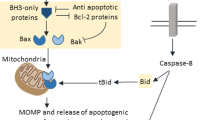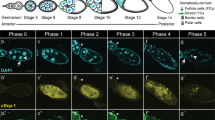Abstract
Apoptosis is defined by several unique morphological nuclear changes, such as chromatin condensation and nuclear fragmentation1. These changes are triggered by the activation of a family of cysteine proteases called caspases2,3, and caspase-activated DNase (CAD/DFF40)4,5 and lamin protease (caspase-6)6,7 have been implicated in some of these changes. CAD/DFF40 induces chromatin condensation in purified nuclei, but distinct caspase-activated factor(s) may be responsible for chromatin condensation8. Here we use an in vitro system to identify a new nuclear factor, designated Acinus, which induces apoptotic chromatin condensation after cleavage by caspase-3 without inducing DNA fragmentation. Immunodepletion experiments showed that Acinus is essential for apoptotic chromatin condensation in vitro, and an antisense study revealed that Acinus is also important in the induction of apoptotic chromatin condensation in cells.
This is a preview of subscription content, access via your institution
Access options
Subscribe to this journal
Receive 51 print issues and online access
$199.00 per year
only $3.90 per issue
Buy this article
- Purchase on Springer Link
- Instant access to full article PDF
Prices may be subject to local taxes which are calculated during checkout





Similar content being viewed by others
References
Kerr,J. F. R., Wyllie,A. H. & Currie,A. R. Apoptosis: a basic biological phenomenon with wide-ranging implications in tissue kinetics. Br. J. Cancer 26, 239–257 (1972).
Salvesen,G. S. & Dixit,V. M. Caspases: intracellular signaling by proteolysis. Cell 91, 443–446 (1997).
Thornberry,N. A. & Lazebnik,Y. Caspases: Enemies within. Science 281, 1312–1316 (1998).
Enari,M. et al. A caspase-activated DNase that degrades DNA during apoptosis, and its inhibitor ICAD. Nature 391, 43–50 (1998).
Liu,X. et al. The 40-kDa subunit DNA fragmentation factor induces DNA fragmentation and chromatin condensation during apoptosis. Proc. Natl Acad. Sci. USA 95, 8461–8466 (1998).
Takahashi,A. et al. Cleavage of lamin A by Mch2α but not CPP32: multiple ICE-related proteases with distinct substrate recognition properties are active in apoptosis. Proc. Natl Acad. Sci. USA 93, 8395–8400 (1996).
Orth,K. et al. The CED-3/ICE-like protease Mch2 is activated during apoptosis and cleaves the death substrate lamin A. J. Biol. Chem. 271, 16443–16446 (1996).
Samejima,K. et al. Transition from caspase-dependent to caspase-independent mechanisms at the onset of apoptotic execution. J. Cell Biol. 143, 225–239 (1998).
Adam,S. A., Marr,R. S. & Gerace,L. Nuclear protein import in permeabilized mammalian cells requires soluble cytoplasmic factors. J. Cell Biol. 111, 807–816 (1990).
Yoneda,Y., Imamoto-Sonobe,N., Yamaizumi,M. & Uchida,T. Reversible inhibition of protein import into the nucleus by wheat germ agglutinin injected into cultured cells. Exp. Cell Res. 173, 586–595 (1987).
Ishikawa,K. et al. Prediction of the coding sequences of unidentified human genes. X. The complete sequences of 100 new cDNA clones from brain which can code for large proteins in vitro. DNA Res. 5, 169–176 (1998).
Samuels,M. E., Schedl,P. & Cline,T. W. The complex set of late transcripts from the Drosophila sex determination gene sex-lethal encodes mutliple related polypeptides. Mol. Cell. Biol. 11, 3584–3602 (1991).
Saraste,M., Sibbald,P. R. & Wittinghofer,A. The P-loop-a common motif in ATP- and GTP-binding proteins. Trends Biochem. Sci. 15, 430–434 (1990).
Susin,S. A. et al. Molecular characterization of mitochondrial apoptosis-inducing factor. Nature 397, 441–446 (1999).
Zhang,J. et al. Resistance to DNA fragmentation and chromatin condensation in mice lacking the DNA fragmentation factor 45. Proc. Natl Acad. Sci. USA 95, 12480–12485 (1998).
Mukae,N. et al. Molecular cloning and characterization of human caspase-activated DNase. Proc. Natl Acad. Sci. USA 95, 9123–9128 (1998).
Yasuhara,N. et al. Essential role of active nuclear transport in apoptosis. Genes Cells 2, 55–64 (1997).
Imamoto,N. et al. In vivo evidence for involvement of a 58 kDa component of nuclear pore-targeting complex in nuclear protein import. EMBO J. 14, 3617–3626 (1995).
Tachibana,T., Hieda,M., Sekimoto,T. & Yoneda,Y. Exogenously injected-nuclear import factor p10/NTF2 inhibits signal-mediated nuclear import and export of proteins in living cells. FEBS Lett. 397, 177–182 (1996).
Melchior,F., Sweet,D. J. & Gerace,L. Analysis of Ran/TC4 function in nuclear protein import. Methods Enzymol. 257, 279–291 (1995).
Gorlich,D., Prehn,S., Laskey,R. A. & Hartman,E. Isolation of a protein that is essential for the first step of nuclear protein import. Cell 79, 767–778 (1994).
Matsudaira,P. A Practical Guide to Protein and Peptide Purification for Microsequencing (Academic, San Diego, 1993).
Hirano,T., Kobayashi,R. & Hirano,M. Condensins, chromosome condensation protein complex containing XCAP-C, XCAP-E and a Xenopus homolog of the Drosophila Barren protein. Cell 89, 511–521 (1997).
Niwa,H., Yamamura,K. & Miyazaki,J. Efficient selection for high-expression transfectants with a novel eukaryotic vector. Gene 108, 193–199 (1991).
Enari,M., Hase,A. & Nagata,S. Apoptosis by a cytosolic extract from Fas-activated cells. EMBO J. 14, 5201–5208 (1995).
Iwahashi,H. et al. Synergistic anti-apoptotic activity between Bcl-2 and SMN implicated in spinal muscular atrophy. Nature 390, 413–417 (1997).
Acknowledgements
We thank O. Ohara and J. Miyazaki for KIAA0670 plasmid and pCAGGS plasmid, respectively, and Y. Sakamoto for help with microsequence analysis. This work was supported in part by grants for Scientific Research on Priority Areas, for COE Research, and for JSPS fellows from the Ministry of Education, Science, Sports and Culture of Japan.
Author information
Authors and Affiliations
Corresponding author
Rights and permissions
About this article
Cite this article
Sahara, S., Aoto, M., Eguchi, Y. et al. Acinus is a caspase-3-activated protein required for apoptotic chromatin condensation. Nature 401, 168–173 (1999). https://doi.org/10.1038/43678
Received:
Accepted:
Issue Date:
DOI: https://doi.org/10.1038/43678
This article is cited by
-
50 years on and still very much alive: ‘Apoptosis: a basic biological phenomenon with wide-ranging implications in tissue kinetics’
British Journal of Cancer (2023)
-
Exploration of Pericyte-Derived Factors Implicated in Lung Cancer Brain Metastasis Protection: A Pilot Messenger RNA Sequencing Using the Blood–Brain Barrier In Vitro Model
Cellular and Molecular Neurobiology (2022)
-
Landfill soil leachates from Nigeria and India induced DNA damage and alterations in genes associated with apoptosis in Jurkat cell
Environmental Science and Pollution Research (2022)
-
Proteome profiling of different rat brain regions reveals the modulatory effect of prolonged maternal separation on proteins involved in cell death-related processes
Biological Research (2021)
-
Protective effects of acetyl-l-carnitine against serum and glucose deprivation-induced apoptosis in rat adipose-derived mesenchymal stem cells
Cell and Tissue Banking (2020)
Comments
By submitting a comment you agree to abide by our Terms and Community Guidelines. If you find something abusive or that does not comply with our terms or guidelines please flag it as inappropriate.



